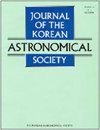Somangnet:韩国小型望远镜网络
IF 0.8
4区 物理与天体物理
Q3 ASTRONOMY & ASTROPHYSICS
引用次数: 3
摘要
即使在8米级望远镜普遍使用的时代,小型望远镜也被认为是非常有价值的研究设备,因为它们可以快速跟踪或长期监测观测。为了最大限度地发挥国内小型望远镜的作用,我们于2020年建立了由国内机构运营的0.4-1.0 m级光学望远镜网络“SomangNet”。在这里,我们对项目进行了概述,描述了目前参与的望远镜,其科学范围和运行模式,以及未来活动的前景。目前,除韩国外,还在澳大利亚、美国、智利等地部署了10台望远镜。目前,许多望远镜的操作都依赖于操作人员,我们计划将它们升级为远程或机器人操作。最新的SomangNet科学项目包括对星系、超新星、活动星系核、共生恒星、太阳系天体、中微子/引力波源和系外行星的监测和后续观测研究。本文章由计算机程序翻译,如有差异,请以英文原文为准。
Somangnet: Small Telescope Network of Korea
Even in an era where 8-meter class telescopes are common, small telescopes are considered very valuable research facilities since they are available for rapid follow-up or long term monitoring observations. To maximize the usefulness of small telescopes in Korea, we established the SomangNet, a network of 0.4-1.0 m class optical telescopes operated by Korean institutions, in 2020. Here, we give an overview of the project, describing the current participating telescopes, its scientific scope and operation mode, and the prospects for future activities. SomangNet currently includes 10 telescopes that are located in Australia, USA, and Chile as well as in Korea. The operation of many of these telescopes currently relies on operators, and we plan to upgrade them for remote or robotic operation. The latest SomangNet science projects include monitoring and follow-up observational studies of galaxies, supernovae, active galactic nuclei, symbiotic stars, solar system objects, neutrino/gravitational-wave sources, and exoplanets.
求助全文
通过发布文献求助,成功后即可免费获取论文全文。
去求助
来源期刊

Journal of the Korean Astronomical Society
地学天文-天文与天体物理
CiteScore
1.30
自引率
10.00%
发文量
0
审稿时长
>12 weeks
期刊介绍:
JKAS is an international scientific journal publishing papers in all fields of astronomy and astrophysics. All manuscripts are subject to the scrutiny of referees. Manuscripts submitted to JKAS must comply with the ethics policy of JKAS. Six regular issues are published each year on February 28, April 30, June 30, August 31, October 31, and December 31. One year''s issues compose one volume.
 求助内容:
求助内容: 应助结果提醒方式:
应助结果提醒方式:


